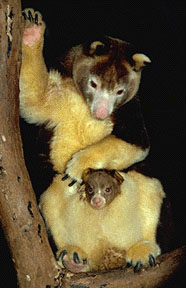
Order: Diprotodontia Prev. Marsupialia
Family: Macropodidae
Genus & Species: Dendrolagus matschiei
APPEARANCE
Matschie's tree kangaroo is an unusual looking marsupial of New Guinea.
They are small in size, only 20-30 in (50-76 cm) in body length - roughly the
size of a wallaby. The long cylindrical, non-prehensile tail is used for
balance while leaping among the branches and is 17- 36 in (42.5-90 cm) in
length. Sexual dimorphism is present, with the females being larger than the
males. Females weigh 17 lbs (7.5 kg) and males weigh 15 lbs (6 kg). The
body is short and stocky, and the forelimbs are almost as long as the
hindlimbs. The feet are shorter and broader than those of ground
kangaroos, and all four end in curved claws used for climbing. Pad-like
patches of roughened skin are located on the feet and aid with gripping. The
feet lack opposable thumbs. The head is small and the eyes are large. The
ears are small and yet larger than those of other tree kangaroo species, and
the feet are shorter.
Matschie's tree kangaroos have thick, dense fur that grow in opposite
directions on the back and nape of the neck, allowing water to easily run off
their body. The fur is mahogany-coloured or red on the back, and bright
yellow on the limbs, feet, tail, and edges of the ears. A dark stripe runs
down the back. The face is yellow and white.
Matschie's tree kangaroos are agile climbers, although less agile than other
tree kangaroo species, and can leap down 30 ft (9 m) to another branch, or
60 ft (12 m) to the ground. On the ground they prefer to walk instead of
hop, but can hop to speeds of 4.8 km/h when in danger. They have a life
span of 14 years in captivity.
HABITAT
Matschie's tree kangaroos are found at an altitude of 3000-5000 ft
(900-1500 m) above sea level. They are located in the mountainous tropical
deciduous and tropical rainforests of New Guinea. They are found
exclusively on Huon Peninsula of Papua New Guinea, as well as on the
nearby island of Umboi.
Matschie's tree kangaroos are arboreal, meaning they live in trees, and
spend little time on the ground. They are solitary creatures and come
together only to mate. The males require a large territory that will overlap
several of the females' smaller territories. They sleep for 60% of their lives,
curled up in the nearest tree. They feed during the day.
FOOD
Matschie's tree kangaroos are considered herbivores, although they will
feed upon animals. The main portion of their diet consists of leaves, but
they will also feed upon flowers, fruits, nuts, bark, sap, bird eggs, bird
young, and insects. In the zoo they are fed fruit leaves, apples, carrots,
corn, kale, timothy hay, spinach leaves, alfalfa, lettuce, celery, and
hard-boiled eggs. They are also fed tea leaves to make up for the tannin
present in the leaves they eat in the wild. Without these leaves, the rich
colours of the coat would dull.
ENEMIES
Matschie's tree kangaroos are primarily hunted by the natives of Papua
New Guinea. They are traditionally hunted by natives with dingos, which
sniff the kangaroos out and grab them from the trees. Doing it this way
allows many of them to escape. However, the introduction of guns to the
island has placed their future in jeopardy. They are hunted for their
succulent meat. Matschie's tree kangaroos are endangered, with only 1400
left in the wild. Breeding programs in zoos worldwide are helping to
conserve this species.
BREEDING
Matschie's tree kangaroos have no defined mating season, although mating
does drop off from October to March in captivity. Females go into heat
every 51-79 days. They have a gestation period of 39-45 days, the longest of
any known marsupial. 1-2 days before birth, the females isolates herself.
She then takes up the birthing position: sitting on the base of her tail with
the tail between her legs. The joey is born less than 1 in (2.5 cm) in length.
It takes 2 min for it to crawl into the mother's pouch, which she cleans right
before birth, and then grab hold of a teat. It remains this way for 100 days.
After 250 days it looks out of the pouch; after 300 days it ventures out; after
350 days it is independent of the pouch.
RELATIVES
There are 8 species of tree kangaroo found in New Guinea and 2 in
Australia.
RESOURCES CITED
1. www.brookfield-zoo.mus.il.us/animals/tree.kangaroo.html
2. www.scz.org/animals/t/matsche.html
3. forests.org/gopher/png/general/treekang.txt
4. www.oit.itd.umich.edu/bio/doc.cgi/Chordata/Mammalia/
Diprotodontia/Macropodidae/Dendrolagus_matschie.ftl
5. www.zooregon.org/cards/treeroos.htm
6. www.phillyzoo.org/pz0008.htm
7. www.oregonzoo.org/News/news.htm